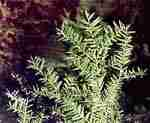
Tsuga canadensis (3).
Common Names
Eastern hemlock, Canada hemlock, pruche du Canada (1), hemlock spruce.Taxonomic notes
Syn: Pinus canadensis Linnaeus 1763 (1).Description
Trees to 30 m; trunk to 150 cm dbh; crown broadly conic. Bark brownish, scaly and fissured. Twigs yellow-brown, densely pubescent. Buds ovoid, 1.5-2.5 mm. Leaves (5)15-20(25) mm, mostly appearing 2-ranked, flattened; abaxial surface glaucous, with 2 broad, conspicuous stomatal bands, adaxial surface shiny green (yellow-green); margins minutely dentate, especially toward apex. Seed cones ovoid, 1.5-2.5 × 1-1.5 cm; scales ovate to cuneate, 8-12 × 7-10 mm, apex ± round, often projected outward. 2n=24 (1).Range
Canada: All provinces east from Ontario, except Newfoundland; USA: All states E from Minnesota, Wisconsin, Indiana, Kentucky, Tennessee and Alabama except Florida; at 600-1800 m elevation. Habitat moist rocky ridges, ravines, and hillsides (1).Big Tree
Height 50 m, dbh 163 cm, crown spread 11.5 m; in Great Smokies National Park, Tennessee (4).Oldest
One tree, sampled in the mid-1980s, had 385 rings at a point approximately 16 m above the base; the center was destroyed by rot below that height. The tree had fallen at that time and is thus dead. The time it took to grow to a 16 m height could have been anything from a few decades to several centuries, since hemlocks have the capability of persisting as understory trees for a very long time before a canopy disturbance permits them to grow into forest dominants. This old tree grew in the Alan Seeger State Forest Monument in central Pennsylvania, in a cove forest that somehow escaped the loggers (5, 6).Dendrochronology
As of Feb-99, there are approximately 60 studies involving this species. They primarily involve a diverse suite of ecological problems including site quality, stand development, insect attack, acid rain, historical land use, and impacts of anthropogenic climate change. It has also seen some use in reconstructing climate variation, archeological studies and numerous relatively esoteric topics. Incidentally, thanks to its distinctive pollen morphology, it is also an extremely important species in reconstructing postglacial vegetation change in the eastern U.S. and Canada.Ethnobotany
The wood is used extensively as construction lumber, and tannins produced by the bark were at one time used for tanning leather (2). The wood, however, tends to be brittle and inferior to that of the other North American hemlocks. Numerous cultivars of Tsuga canadensis have been developed, including compact shrubs, dwarfs, and graceful trees (1).Eastern hemlock (Tsuga canadensis) is the state tree of Pennsylvania (1).
Observations
Seen in Great Smokies National Park, Tennessee and Killarney Provincial Park, Ontario.Remarks
Citations
(1) Taylor, Ronald J. at the Flora of North America web site.(2) "Hemlock," Encarta 97.
(3) Elias, Thomas S. 1987. The complete trees of North America; a field guide and natural history. NY: Gramercy Publ. Co.
(4) American Forests. 1996. The 1996-1997 National Register of Big Trees. Washington, DC: American Forests.
(5) J.H. Gove and S.E. Fairweather. 1988. Tree-ring analysis of a 500-year old hemlock in central Pennsylvania. U.S. Forest Service General Technical Report NC-120, Vol. 1, pp. 483-489.
(6) Jeffrey H.Gove, pers. comm. 22-Feb-1999.
See also:
Burns, R.M. and B.H. Honkala. 1990. Silvics of North America, Vol. 1, Conifers. Washington DC: U.S.D.A. Forest Service Agriculture Handbook 654. http://willow.ncfes.umn.edu/silvics_manual/Table_of_contents.htm.
Farjon, A. 1990. Pinaceae: drawings and descriptions of the genera Abies, Cedrus, Pseudolarix, Keteleeria, Nothotsuga, Tsuga, Cathaya, Pseudotsuga, Larix and Picea. Königstein: Koeltz Scientific Books.
Prasad, Anantha M. and Louis R. Iverson. 1999. A Climate Change Atlas for 80 Forest Tree Species of the Eastern United States. http://www.fs.fed.us/ne/delaware/atlas/. Delaware, Ohio: USFS Northeastern Research Station.
back | Tsuga | Pinaceae | home
This page is from the Gymnosperm Database
URL: http://www.geocities.com/~earlecj/pi/ts/canadensis.htm
Edited by Christopher J. Earle
E-mail:earlecj@earthlink.com
Last modified on 21-Nov-1999
